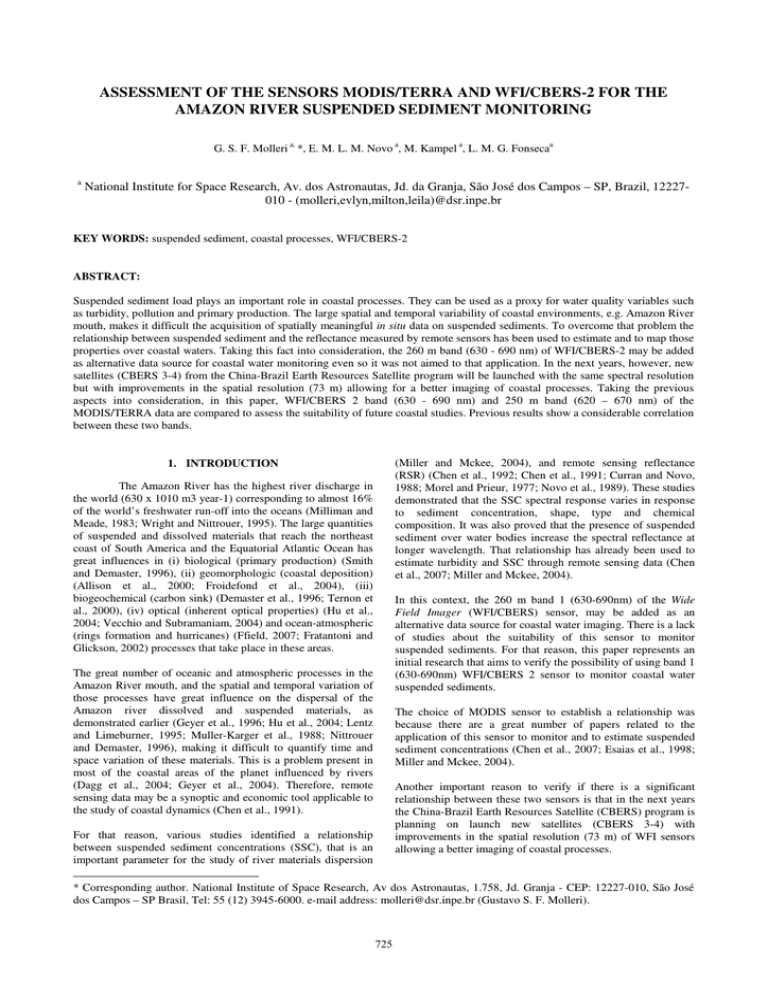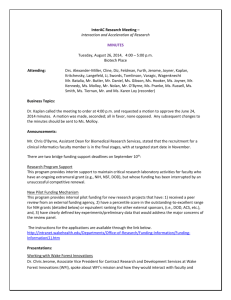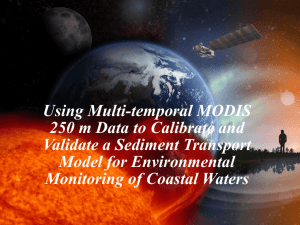ASSESSMENT OF THE SENSORS MODIS/TERRA AND WFI/CBERS-2 FOR THE
advertisement

ASSESSMENT OF THE SENSORS MODIS/TERRA AND WFI/CBERS-2 FOR THE AMAZON RIVER SUSPENDED SEDIMENT MONITORING G. S. F. Molleri a, *, E. M. L. M. Novo a, M. Kampel a, L. M. G. Fonsecaa a National Institute for Space Research, Av. dos Astronautas, Jd. da Granja, São José dos Campos – SP, Brazil, 12227010 - (molleri,evlyn,milton,leila)@dsr.inpe.br KEY WORDS: suspended sediment, coastal processes, WFI/CBERS-2 ABSTRACT: Suspended sediment load plays an important role in coastal processes. They can be used as a proxy for water quality variables such as turbidity, pollution and primary production. The large spatial and temporal variability of coastal environments, e.g. Amazon River mouth, makes it difficult the acquisition of spatially meaningful in situ data on suspended sediments. To overcome that problem the relationship between suspended sediment and the reflectance measured by remote sensors has been used to estimate and to map those properties over coastal waters. Taking this fact into consideration, the 260 m band (630 - 690 nm) of WFI/CBERS-2 may be added as alternative data source for coastal water monitoring even so it was not aimed to that application. In the next years, however, new satellites (CBERS 3-4) from the China-Brazil Earth Resources Satellite program will be launched with the same spectral resolution but with improvements in the spatial resolution (73 m) allowing for a better imaging of coastal processes. Taking the previous aspects into consideration, in this paper, WFI/CBERS 2 band (630 - 690 nm) and 250 m band (620 – 670 nm) of the MODIS/TERRA data are compared to assess the suitability of future coastal studies. Previous results show a considerable correlation between these two bands. (Miller and Mckee, 2004), and remote sensing reflectance (RSR) (Chen et al., 1992; Chen et al., 1991; Curran and Novo, 1988; Morel and Prieur, 1977; Novo et al., 1989). These studies demonstrated that the SSC spectral response varies in response to sediment concentration, shape, type and chemical composition. It was also proved that the presence of suspended sediment over water bodies increase the spectral reflectance at longer wavelength. That relationship has already been used to estimate turbidity and SSC through remote sensing data (Chen et al., 2007; Miller and Mckee, 2004). 1. INTRODUCTION The Amazon River has the highest river discharge in the world (630 x 1010 m3 year-1) corresponding to almost 16% of the world’s freshwater run-off into the oceans (Milliman and Meade, 1983; Wright and Nittrouer, 1995). The large quantities of suspended and dissolved materials that reach the northeast coast of South America and the Equatorial Atlantic Ocean has great influences in (i) biological (primary production) (Smith and Demaster, 1996), (ii) geomorphologic (coastal deposition) (Allison et al., 2000; Froidefond et al., 2004), (iii) biogeochemical (carbon sink) (Demaster et al., 1996; Ternon et al., 2000), (iv) optical (inherent optical properties) (Hu et al., 2004; Vecchio and Subramaniam, 2004) and ocean-atmospheric (rings formation and hurricanes) (Ffield, 2007; Fratantoni and Glickson, 2002) processes that take place in these areas. In this context, the 260 m band 1 (630-690nm) of the Wide Field Imager (WFI/CBERS) sensor, may be added as an alternative data source for coastal water imaging. There is a lack of studies about the suitability of this sensor to monitor suspended sediments. For that reason, this paper represents an initial research that aims to verify the possibility of using band 1 (630-690nm) WFI/CBERS 2 sensor to monitor coastal water suspended sediments. The great number of oceanic and atmospheric processes in the Amazon River mouth, and the spatial and temporal variation of those processes have great influence on the dispersal of the Amazon river dissolved and suspended materials, as demonstrated earlier (Geyer et al., 1996; Hu et al., 2004; Lentz and Limeburner, 1995; Muller-Karger et al., 1988; Nittrouer and Demaster, 1996), making it difficult to quantify time and space variation of these materials. This is a problem present in most of the coastal areas of the planet influenced by rivers (Dagg et al., 2004; Geyer et al., 2004). Therefore, remote sensing data may be a synoptic and economic tool applicable to the study of coastal dynamics (Chen et al., 1991). The choice of MODIS sensor to establish a relationship was because there are a great number of papers related to the application of this sensor to monitor and to estimate suspended sediment concentrations (Chen et al., 2007; Esaias et al., 1998; Miller and Mckee, 2004). Another important reason to verify if there is a significant relationship between these two sensors is that in the next years the China-Brazil Earth Resources Satellite (CBERS) program is planning on launch new satellites (CBERS 3-4) with improvements in the spatial resolution (73 m) of WFI sensors allowing a better imaging of coastal processes. For that reason, various studies identified a relationship between suspended sediment concentrations (SSC), that is an important parameter for the study of river materials dispersion * Corresponding author. National Institute of Space Research, Av dos Astronautas, 1.758, Jd. Granja - CEP: 12227-010, São José dos Campos – SP Brasil, Tel: 55 (12) 3945-6000. e-mail address: molleri@dsr.inpe.br (Gustavo S. F. Molleri). 725 The International Archives of the Photogrammetry, Remote Sensing and Spatial Information Sciences. Vol. XXXVII. Part B8. Beijing 2008 2. METHODS Both MODIS/TERRA and WFI/CBERS 2 images can be acquired at no cost through the sites of the Land Processes Distributed Active Archive Center (LP DAAC) (http://lpdaac.usgs.gov/main.asp) for MODIS/TERRA images and the National Institute of Space Research (http://www.cbers.inpe.br) for WFI/CBERS 2 images. Despite of the different radiometric resolution 12 bits (MODIS) and 8 bits (WIF), these sensors have spatial and spectral resolutions very similar (Table 1). The passage time of the satellites through the Amazon River mouth is, also, very similar,10:42h for CBERS 2 and 10:30h for TERRA. In Table 1 are presented the principal characteristics of the two sensors and the satellites. Sensor Wavelength band 1 (nm) Altitude (km) Polar inclination Swath width View angle (nadir) Imaged area (km²) MODIS WFI 620-670 630-690 705 98.2˚ 55˚ 0˚ 2330 778 98.5˚ 60˚ 32.62˚ 890 Radiometric resolution (bits) 12 8 Spatial resolution (meters) 250 260 Figure 1 – MODIS/TERRA mosaiced and in reflectance values image, day 01/26/2004 – passage time 10:30h, utilized in this paper. The study area is delimited with a red line. Table 1 – Principal characteristics of MODIS/TERRA and WFI/CBERS 2 sensors For this study, it were acquired a WFI and MODIS images of the day 01/26/2004 (Figure 1 and 2). This day presented low cloud cover allowing for a more precise comparison between the spectral responses of these two sensors regarding suspended sediment concentration at Amazon River mouth. The MODIS image used in this paper was obtained by mosaciking 4 MODIS scenes of the product MOD 09 tiles (h12 v08, h12 v09, h13 v08 and h13 v09) with the aid of the MODIS Reprojection Tool (MRT). The WFI/CBERS 2 image was georeferenced based on MODIS/TERRA mosaic with a mean error of 0.4 pixels. This image was transformed to reflectance values through the atmospheric correction model 5S (Tanré et al., 1990). Initially, both WFI and MODIS images had the clouds and land masked as demonstrated in Figure 1. The pixels inside the study area of the MODIS/TERRA image that presented reflectance values equal to zero were also masked, because the objective of this study is to identify if there is a significant relationship between the spectral responses of these two sensors to SSC. Thus a linear correlation was carried out with a total of 726.703 pixels, located inside the study area. The assumption behind this approach was that the higher the correlation between reflectance values, the more similar the sensors performance was. Figure 2. WFI/CBERS 2 image in reflectance values, day 01/26/2004 – passage time 10:42h, utilized in this paper. The study area is delimited with a red line. It was also verified the spectral responses variation of the two sensors through a map generated by the subtraction, of the 726 The International Archives of the Photogrammetry, Remote Sensing and Spatial Information Sciences. Vol. XXXVII. Part B8. Beijing 2008 atmospheric correction applied at the WFI image by the 5S model may also be a source of errors. Calibraton errors between the two sensores were already mentioned at previous work (Li et al., 2005) pixels inside the study area, of MODIS/TERRA reflectance image minus WFI /CBERS2 reflectance image. 3. RESULTS AND DISCUSSION Even though in spite of all these radiometric differences cited before the mean difference in reflectance values between the responses of the sensors MODIS and WFI is 0.07. The linear correlation between MODIS/TERRA and WFI/CBERS 2 images presented a r² = 0.85 and a rmse = 0.023 (Figure 3). Figures 3 and 4 demonstrates that to almost every MODIS pixel values, inside the study area, there is a significant error from the values extracted from the pixels of the reflectance image of WFI. Figure 3. Linear correlation between WFI/CBERS 2 reflectance images and MODIS/TERRA reflectance images. Through the Figure 4 is possible to notice that, in general, the reflectance image of the WFI sensor is overestimating the reflectance measured by MODIS/TERRA sensor for the pixels inside the study area. Figure 4. Map generated by the subtraction, of the pixels inside the study area, of MODIS/TERRA reflectance image minus WFI /CBERS2 reflectance image. This dissimilarity can be explained by the different passage time of the sensors by the study area. Even the small difference of 12 minutes can generate large variation in the spectral response through the dynamics of the water characteristics in the Amazon River mouth. 4. CONCLUSIONS This paper presented a preliminary assessment of WFI/CBERS 2 sensor to monitor SSC at Amazon River mouth as an additional source of data. Even with different characteristics, the WFI/CBERS 2 reflectance image and MODIS/TERRA reflectance image demonstrated a good linear correlation (r² = 0.85 and rmse = 0.023). The mean error difference in the reflectance of MODIS WFI images 0.07. The different radiometric resolutions of both sensors may be an important reason for such errors too. The 12 bits spectral resolution of MODIS sensor makes it possible to detect smaller differences at the water components reflectance that are not detected by WFI sensor (8 bits). The principal features that explain the differences between the two images are: (1) different passage time, (2) different spectral and radiometric resolution, and (3) different view angles (swath effects or FOV effects). Since both images were generated by different view angles, is expected a dissimilarity at the energy reflected that reached each sensor. This difference can create areas were there is more influence of the sun energy incidence angle. That can produce an additional effect to the energy acquired by the sensor. This could explain why the highest differences between the two images analyzed are more localized at the right side of the study area (Figure 4). Therefore, as future works, the authors suggest: (a) to increase the number of MODIS and WFI images, (b) to test different atmospheric correction models with the WFI image and (c) to redo the tests carried out in this study to different research sites. The other important fact to take into account is the fact that WFI sensor was not originally created to detect such a small radiance values as the ones detected over water bodies. The 727 The International Archives of the Photogrammetry, Remote Sensing and Spatial Information Sciences. Vol. XXXVII. Part B8. Beijing 2008 Deep-Sea Research II, v. 51, n. (10-11), pp. 1151– 1171. Lentz, S. J.; Limeburner, R. 1995. The Amazons River Plume during AMASSEDS: Spatial characteristics and salinity variability. Journal of Geophysical Research, v. 100, n. (C2), pp. 2355-2375. Li, X.; Gu, X.; Yu, T.; Fu, Q.; Zhang, Y.; Li, X., 2005. The Role of Radiometric Calibration for the Vegetation Indices of CBERS-02 WFI. In: Geoscience and Remote Sensing Symposium, IGARSS pp. 2235-2238. Miller, R. L.; Mckee, B. A. 2004. Using MODIS Terra 250 m imagery to map concentrations of total suspended matter in coastal waters. Remote Sensing of Environment, v. 93, n. (1-2), pp. 259–266. Milliman, J. D.; Meade, R. H. 1983. World-wide delivery of river sediment to the oceans. Journal of Geology, v. 91, n. (1), pp. 1-21. Morel, A.; Prieur, L. 1977. Analysis of variations in ocean color. Limnology and Oceanography, v. 22, n. (4), pp. 709-722. Muller-Karger, F. E.; Mcclain, C. R.; Richardson, P. L. 1988. The dispersal of the Amazon's water. Nature, v. 333, n., pp. 56-58. Nittrouer, C. A.; Demaster, D. J. 1996. The Amazon shelf setting: tropical, energetic, and influenced by a large river. Continental Shelf Research, v. 16, n. (5-6), pp. 553-573. Novo, E. M. M.; Hansom, J. D.; Curran, P. J. 1989. The effect of sediment type on the relationship between reflectance and suspended sediment concentration. International Journal of Remote Sensing, v. 10, n. (7), pp. 1283-1289. Smith, W. O.; Demaster, D. J. 1996. Phytoplankton biomass and productivity in the Amazon River plume: correlation with seasonal river discharge. Continental Shelf Research, v. 16, n. (3), pp. 291-319. Tanré, D.; Deroo, C.; Duhaut, P.; Herman, M.; Morcrette, J. J. 1990. Description of a computer code to simulate the satellite signal in the solar spectrum: the 5S code. International Journal of Remote Sensing, v. 11, n. (4), pp. 659-668. Ternon, J. F.; Oudot, C.; Dessier, A.; Diverres, D. 2000. A seasonal tropical sink for atmospheric CO2 in the Atlantic ocean: the role of the Amazon River discharge. Marine Chemistry, v. 68, n. (3), pp. 183– 201. Vecchio, R. D.; Subramaniam, A. 2004. Influence of the Amazon River on the surface optical properties of the western tropical North Atlantic Ocean. Journal of Geophysical Research, v. 109, n. (C11001), pp. 1-13. Wright, L. D.; Nittrouer, C. A. 1995. Dispersal of River Sediments in Coastal Seas: Six Contrasting Cases. Estuaries, v. 18, n. (3), pp. 494-508. 5. REFERENCES Allison, M. A.; Lee, M. T.; Ogston, A. S.; Aller, R. C. 2000. Origin of Amazon mudbanks along the northeastern coast of South America. Marine Geology, v. 163, n. (1-4), pp. 241–256. Chen, Z.; Curran, P. J.; Hansom, J. D. 1992. Derivative reflectance spectroscopy to estimate suspended sediment concentration. Remote Sensing of Environment, v. 40, n. (1), pp. 67-77. Chen, Z.; Hanson, J. D.; Curran, P. J. 1991. The form of the relationship between suspended sediment concentration and spectral reflectance: its implications for the use if Daedalus1268 data. Remote Sensing Letters, v. 12, n. (1), pp. 215-222. Chen, Z.; Hu, C.; Muller-Karger, F. 2007. Monitoring turbidity in Tampa Bay using MODIS/Aqua 250-m imagery. Remote Sensing of Environment, v. 109, n. (2), pp. 207–220. Curran, P. J.; Novo, E. M. M. 1988. The relationship between suspended sediment concentration and remotely sensed spectral radiance: a review. Journal of Coastal Research, v. 4, n. (3), pp. 351-368. Dagg, M.; Benner, R.; Lohrenz, S.; Lawrence, D. 2004. Transformation of dissolved and particulate materials on continental shelves influenced by large rivers: plume processes. Continental Shelf Research, v. 24, n. (7-8), pp. 833–858. Demaster, D. J.; Smith, W.; Nelson, D. M.; Aller, J. Y. 1996. Biogeochemical processes in Amazon shelf waters: chemical distributions and uptake rates of silicon, carbon and nitrogen. Continental Shelf Research, v. 16, n. (5-6), pp. 617-643. Esaias, W. E.; Abbott, M. R.; Barton, I.; Brown, O. B.; Campbell, J. W.; Carder, K. L.; Clark, D. K.; Evans, R. H.; Hoge, F. E.; Gordon, H. R.; Balch, W. M.; Letelier, R.; Minnett, P. J. 1998. An Overview of MODIS Capabilities for Ocean Science Observations. IEEE Transactions on Geoscience and Remote Sensing, v. 36, n. (4), pp. 1250-1265. Ffield, A. 2007. Amazon and Orinoco River Plumes and NBC Rings: Bystanders or Participants in Hurricane Events? Journal of Climate, v. 20, n. (2), pp. 316– 333 Fratantoni, D. M.; Glickson, D. A. 2002. North Brazil Current ring generation and evolution observed with SeaWiFS. Journal of Physica Oceanography, v. 32, n. (3), pp. 1058-1074. Froidefond, J. M.; Lahet, F.; C. Huc, D. D.; Guiral, D.; Prost, M. T.; Ternon, J.-F. 2004. Mudflats and mud suspension observed from satellite data in French Guiana. Marine Geology, v. 208, n. (2-4), pp. 153– 168. Geyer, W. R.; Beardsley, R. C.; Lentz, S. J.; Candela, J.; Limeburner, R.; Johns, W. E.; Castro, B. M.; Soares, I. D. 1996. Physical oceanography of the Amazon shelf. Continental Shelf Research, v. 16, n. (5-6), pp. 575-616. Geyer, W. R.; Hill, P. S.; Kineke, G. C. 2004. The transport, transformation and dispersal of sediment by buoyant coastal flows. Continental Shelf Research, v. 24, n. (7-8), pp. 927–949. Hu, C.; Montgomery, E. T.; Schmitt, R. W.; Muller-Karger, F. E. 2004. The dispersal of the Amazon and Orinoco River water in the tropical Atlantic and Caribbean Sea: observation from space and S-PALACE floats. 728




